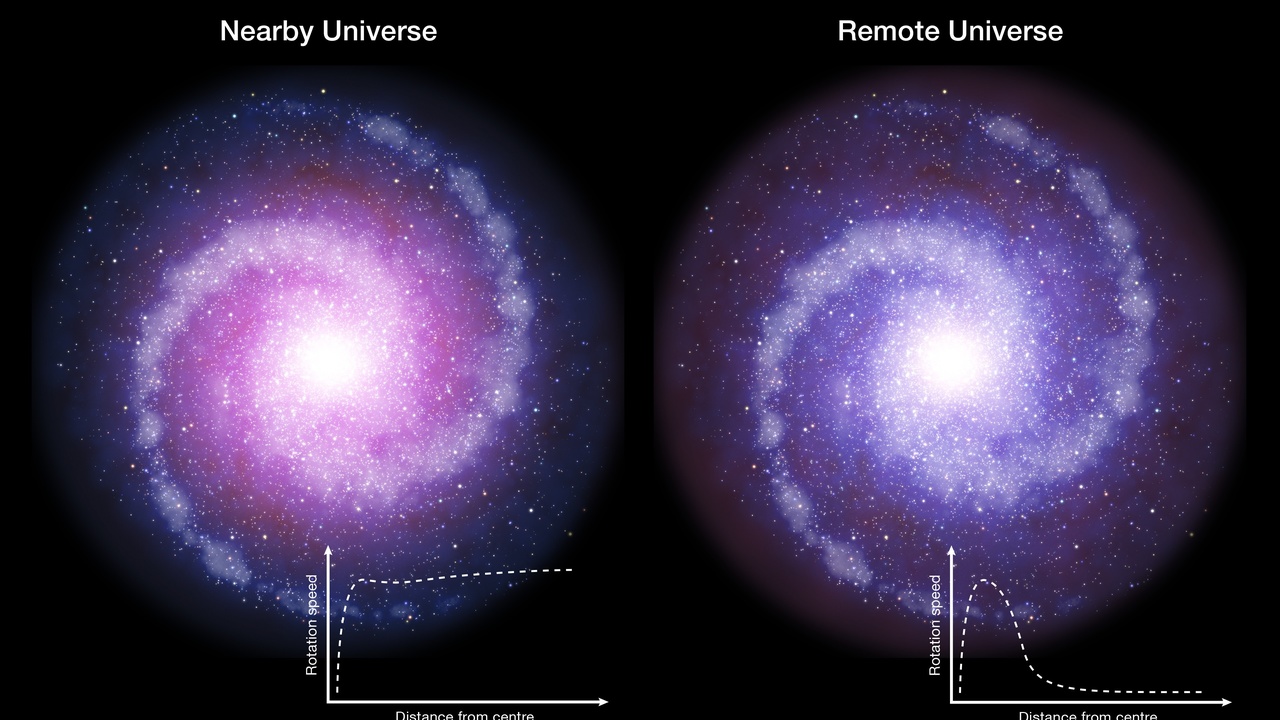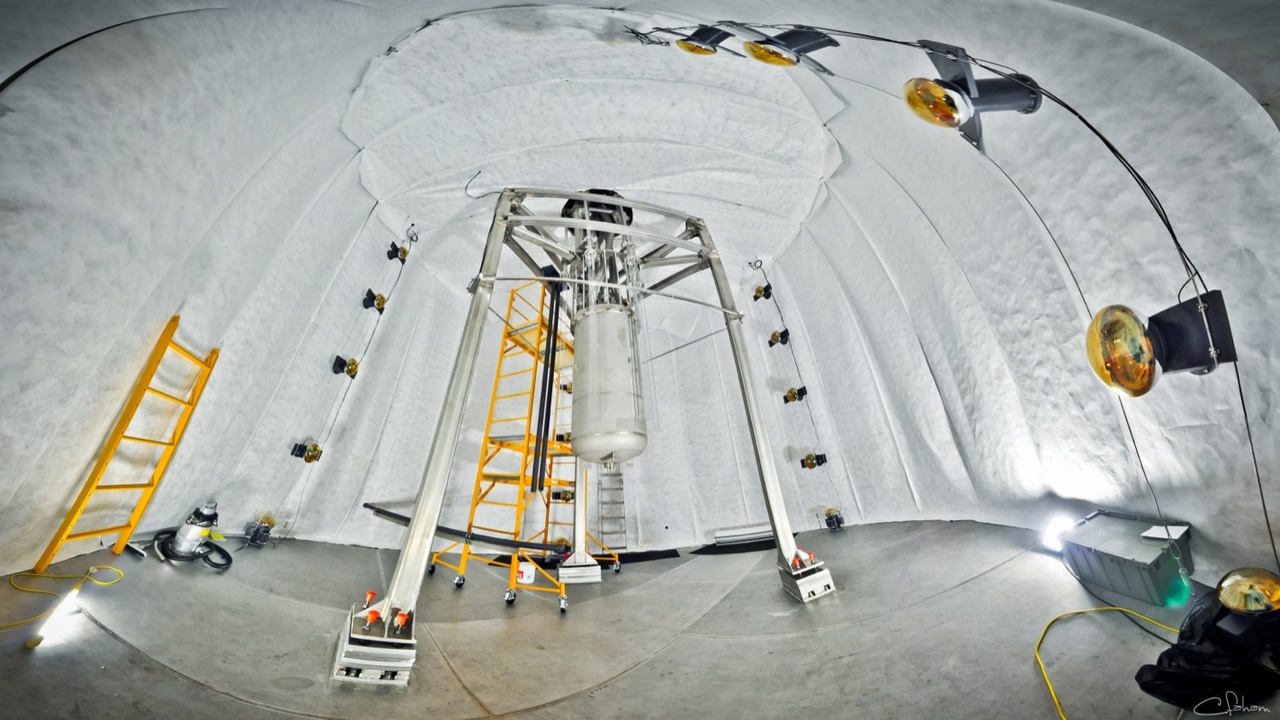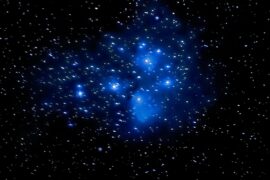In 1933, Fritz Zwicky noticed galaxies in the Coma cluster were moving too fast for the visible mass to hold them together — an early hint that something invisible was shaping the cosmos. Decades later, in the 1970s, Vera Rubin’s rotation-curve measurements showed stars orbiting galactic centers at speeds that require far more mass than the stars and gas we can see.
Dark matter is one of modern astronomy’s deepest unknowns: it dominates the mass budget of galaxies (about 85% of their matter) and makes up roughly 27% of the Universe’s total energy budget (Planck results). The stakes are high. Solve the particle identity and you reshape particle physics; pin down its astrophysical behavior and you rewrite galaxy formation history. This piece lists a dozen clear, concrete mysteries about dark matter, grouped into four categories — particle and physics puzzles; astrophysical and cosmological puzzles; detection and experimental challenges; implications and alternatives — and for each item I give the evidence, why it matters, and concrete examples you can follow. These are the pressing mysteries about dark matter that researchers are actively testing right now.
Cosmic and Particle Physics Mysteries

This category asks the most fundamental question: what is the invisible stuff? Particle identity matters because different particles imply different formation histories, different cosmic signatures, and very different laboratory searches. Leading candidates include WIMPs (weakly interacting massive particles), axions, and sterile neutrinos, and each sits in a different mass-and-interaction regime.
Why it matters: a WIMP at the weak scale fits neatly into the thermal freeze-out story and connects to physics beyond the Standard Model. An axion ties to solutions of the strong-CP problem and behaves like a coherent field, while a keV sterile neutrino would be a warm-dark-matter particle that suppresses small-scale structure. Those properties direct experiments — colliders and missing-energy signatures for some WIMPs, haloscopes for µeV axions, X-ray searches for decaying sterile neutrinos.
Answers here ripple into cosmology: the particle mass and interactions set free-streaming lengths, halo formation, and the abundance of small galaxies. That means collider physicists, astronomers, and detector engineers all need to talk to each other.
1. What is dark matter made of?
We still don’t know the particle (or particles) that make up dark matter. Observational clues date back to Zwicky’s 1933 mass discrepancy and Rubin’s rotation curves in the 1970s, while Planck’s 2018 cosmology fixes dark matter at roughly 27% of the Universe’s energy density and about 85% of all matter.
Leading hypotheses include WIMPs, axions, and sterile neutrinos. Thermal WIMPs naturally predict weak-scale cross sections through freeze-out, axions appear as very light, coherent fields and are targeted by haloscopes like ADMX, and sterile neutrinos in the keV range act as warm dark matter with measurable effects on small-scale structure.
Knowing the particle would reshape particle theory and guide detector design — from tonne-scale liquid xenon chambers to microwave cavities scanning µeV ranges — so the experimental choices today follow the particle physics we think most plausible.
2. Are there multiple dark matter components?
Dark matter might not be a single species. A mixed dark sector — say axions plus a heavier particle — could behave differently across scales, with one component dominating galaxy dynamics and another affecting cosmic background measurements.
Evidence for mixtures would come from mismatches between small-scale structure and large-scale cosmology. Warm components erase low-mass halos depending on their free-streaming lengths, while cold components form the dense halos seen in simulations. Different masses and interaction strengths change clustering and core densities.
Practical impact: experiments would need a portfolio approach. Haloscopes for µeV axions, X-ray telescopes for keV sterile neutrinos, and direct-detection programs for heavier candidates would all remain necessary. Structure-formation simulations that include mixed components provide a way to compare models against dwarf-galaxy counts and lensing maps.
3. Why hasn’t collider or laboratory physics found it?
Decades of searches have not produced a definitive laboratory detection. Direct-detection experiments and collider searches have steadily excluded swaths of parameter space for many canonical models.
Null results from liquid-xenon detectors (LUX, XENON1T and successors) have pushed WIMP-nucleon cross-section limits down by orders of magnitude, while the Large Hadron Collider constrains some production channels through missing-energy events. XENON1T’s 2018-era results included an electron-recoil excess that generated interest but did not identify dark matter.
The experimental lesson is clear: detectors must go larger, purer, and quieter. Deep-underground laboratories, extreme radiopurity, and inventive techniques (directional detection, ultralow thresholds) are the response to a stubbornly elusive particle.
Astrophysical and Cosmological Puzzles

Astronomy gives us the dark-matter story on many scales. The cosmic microwave background and large-scale structure fit a cold-dark-matter framework beautifully, but observations of the smallest galaxies expose tensions. Resolving those tensions tells us whether the problem lies in the physics of dark matter or in messy, baryon-driven astrophysics.
Planck’s precision measurements pin down cosmological parameters and the initial perturbation spectrum, yet the Local Group reveals puzzles: the missing-satellites problem (too few observed dwarf galaxies) and the cusp-core mismatch (simulations predict dense central cusps where some dwarfs show cores). These issues affect how we interpret galaxy surveys and choose targets for indirect searches.
New observational programs — deep imaging, spectroscopic follow-up, and improved hydrodynamic simulations — are testing whether feedback from stars and supernovae can reshape halos or whether alternative dark-matter physics (warm or self-interacting variants) is needed.
4. How exactly does dark matter shape galaxies?
Dark matter provides the gravitational scaffolding for galaxies. Rotation curves, gravitational lensing, and N-body simulations all point to extended dark halos that determine rotation speeds and stability.
Halos can extend tens to hundreds of kiloparsecs and follow empirical scaling relations between halo mass and stellar mass. Observations use rotation curves (Rubin’s classic work), weak and strong lensing reconstructions, and satellite kinematics to map these halos.
Why it matters: halo shapes govern gas inflow, star-formation histories, and the survivability of dwarf galaxies. Accurately mapping halos is essential for interpreting surveys and for understanding where to look for indirect annihilation or decay signals.
5. What role did dark matter play in early structure formation?
Dark matter amplified tiny density fluctuations after recombination, letting structure grow long before baryons could cool and form stars. The CMB anisotropies measured by Planck quantify those initial fluctuations and the relative matter content at recombination (about 380,000 years after the Big Bang).
Because dark matter doesn’t couple to radiation, it began clumping earlier than the baryons, allowing the first halos to form and shepherd gas into sites where the first stars ignited a few hundred million years later. That timing is crucial for interpreting early-Universe observations from facilities like JWST.
Understanding dark matter’s behavior at high redshift shapes expectations for the first galaxies, reionization history, and the faint-end counts in deep surveys. Different dark-matter models predict different halo formation rates and thus different observable signatures in the early Universe.
6. Why do small-scale observations disagree with simulations?
Cold-dark-matter N-body simulations predict many small subhalos and cuspy central density profiles, yet observations sometimes show fewer satellites and core-like centers in dwarfs. That’s the heart of small-scale tension.
Possible resolutions divide into two camps. One invokes baryonic physics — stellar feedback, supernova winds, and tidal stripping — which can erase small galaxies and flatten central cusps. The other invokes alternative dark-matter physics: warm dark matter suppresses low-mass structure, while self-interacting dark matter (SIDM) produces cores through heat transfer.
Distinguishing these requires comparing high-resolution simulations that include realistic gas physics against observations of dwarf galaxies, stellar streams, and satellite counts in the Milky Way and Andromeda.
Detection and Experimental Challenges

Detecting a particle that interacts extremely weakly with normal matter is a technical tour-de-force. Experiments must suppress radioactive backgrounds, cosmic rays, and detector noise while scaling up target mass. That leads to deep-underground facilities, multi-ton detectors, and highly controlled materials.
Direct searches have moved to tonne-scale liquid-xenon detectors and cryogenic crystals, improving sensitivity by orders of magnitude over a decade. Indirect searches look for annihilation or decay products in gamma rays, X-rays, and cosmic rays, but those signals often sit atop messy astrophysical backgrounds.
Practical challenges push innovation: lower thresholds for light dark-matter candidates, directional detectors to confirm a Galactic signal, and accelerator-based beam-dump experiments to probe dark-sector mediators. The program is broad because the particle could hide anywhere.
7. Why do direct-detection experiments keep returning null results?
Direct-detection sensitivity has improved dramatically, yet a convincing WIMP signal remains absent. Experiments now operate with tonne-scale targets and backgrounds reduced to tiny levels, steadily excluding large regions of canonical parameter space.
To give a sense of scale, current liquid-xenon detectors probe spin-independent cross sections well below 10^-46 cm² for 30–100 GeV masses. XENON1T (notable results around 2018) paved the way for XENONnT and LZ, which push further down in cross section and lower thresholds.
Null results force theorists to shift focus to lighter or more weakly interacting candidates, asymmetric dark matter, or hidden-sector scenarios, and they motivate novel detector concepts like directional detection and sub-eV threshold devices.
8. Are astronomical signals ambiguous?
Indirect-detection efforts have produced intriguing excesses, but interpreting them is challenging because ordinary astrophysical sources can mimic dark-matter signatures. The Galactic Center GeV gamma-ray excess seen by Fermi-LAT since the late 2000s is a prime example.
That excess can be modeled as dark-matter annihilation, but populations of millisecond pulsars or unmodeled diffuse emission also fit the data. Similarly, tentative X-ray or gamma-ray lines have generated debate over instrumental effects, astrophysical origins, or dark-matter decay.
The remedy is multi-messenger follow-up: cross-checks with radio, X-ray, and gravitational-wave observations, population studies of candidate astrophysical sources, and improved background modeling. Only then can a signal be confidently attributed to the dark sector.
9. Could dark matter interact through unknown forces?
There may be a hidden sector with its own forces that couple weakly to ours. Models with a dark photon, or with self-interacting dark matter (SIDM), alter halo structure and can address small-scale puzzles by introducing velocity-dependent scattering.
Observationally, SIDM flattens dwarf-galaxy cores while leaving cluster-scale dynamics relatively intact if the cross section depends on velocity. Experimentally, dark-photon searches at fixed-target experiments and low-energy accelerators can probe the mediators that connect the sectors.
Recognizing a dark force would broaden the search strategy: accelerator-based beam dumps, dedicated low-mass detectors, and astrophysical probes of halo heating and substructure would become priorities.
Implications and Theoretical Alternatives

Finding dark matter — or ruling out broad swaths of particle models — has big implications. Alternatives such as modified-gravity theories remain competitive on some galactic scales, and speculative links to dark energy or extra dimensions persist in theoretical work. Any confirmed discovery would redirect decades of research and seed new technologies.
Testing alternatives is empirical. MOND-like scalings fit some rotation-curve regularities, but the cosmic microwave background and large-scale structure align more naturally with particulate dark matter. Unified theories that tie dark matter to quintessence fields or Kaluza-Klein states make distinct predictions testable by precision cosmology and accelerators.
Beyond pure science, detector and materials technology developed for dark-matter searches often find uses in medicine, security, and industry. The broader impacts include trained people, advanced instrumentation, and new research infrastructure.
10. Is modified gravity a better fit than dark matter?
Modified-gravity theories like MOND (and relativistic extensions such as TeVeS) aim to explain galaxy rotation curves without unseen mass. At galaxy scales, MOND reproduces several scaling relations, notably the baryonic Tully–Fisher relation.
However, on cosmological scales — the CMB acoustic peaks, large-scale structure growth, and cluster dynamics — particle dark matter fits the data more consistently. Clusters and the detailed shape of the power spectrum remain difficult for most modified-gravity proposals.
That said, modified-gravity ideas drive useful tests. Measuring gravity’s behavior from dwarf galaxies to clusters and comparing lensing and dynamical mass offers a path to falsify one approach or the other.
11. Could dark matter be linked to dark energy or extra dimensions?
Speculative but research-driven ideas try to link dark-sector phenomena. Some models introduce hidden fields that contribute to both dark matter and cosmic acceleration, while extra-dimension scenarios produce Kaluza–Klein states that behave like massive dark particles.
These ideas are constrained by precision cosmology and laboratory bounds. Gravitational-wave measurements, improved CMB and large-scale surveys, and dedicated searches at accelerators offer concrete tests of unified scenarios.
Though speculative, these hypotheses are attractive because they promise a single explanation for multiple puzzles. If one of them pans out, it would reorient theoretical priorities and funding for decades.
12. What would a confirmed dark-matter discovery mean for technology and society?
A confirmed detection would open a new field of applied research. History shows basic discoveries — think transistors or nuclear physics — can lead to unforeseen technologies years later. In the nearer term, discovery refines particle physics and cosmology and creates demand for new instruments and facilities.
Detector development already spins off: low-noise electronics, cryogenics, and radiation-suppression techniques find uses in medical imaging and materials analysis. Large collaborations train thousands of scientists and engineers, boosting the workforce and spawning startups.
Support for basic research pays dividends in trained personnel, technology transfer, and a stronger scientific culture. Follow the experiments—LZ, XENONnT, ADMX—and back the long-term work; the payoff may arrive decades from now, but it can be profound.
Summary
- Historic clues (Zwicky 1933; Rubin, 1970s) show galaxies need unseen mass, yet the particle identity remains unknown.
- A dozen testable puzzles span particle identity, mixed dark sectors, small-scale structure tensions, and experimental ambiguities.
- Laboratory searches and astronomical surveys are steadily improving sensitivity—examples include LZ, XENONnT, and ADMX—so answers are likely to come from coordinated, multi-pronged efforts.
- Resolving these mysteries will reshape fundamental physics and produce technological and workforce benefits over the long term.
Enjoyed this article?
Get daily 10-minute PDFs about astronomy to read before bed!
Sign up for our upcoming micro-learning service where you will learn something new about space and beyond every day while winding down.







